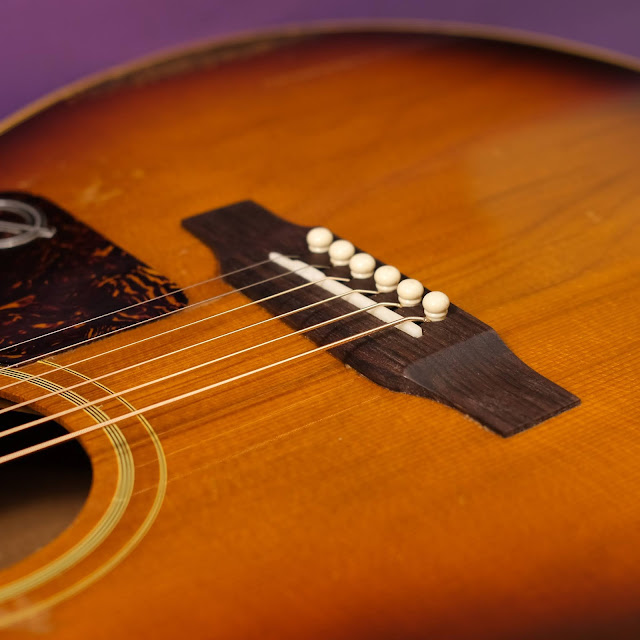1967 Gibson-made Epiphone FT-79 Texan Slope Dreadnought Guitar
Mm-mm-mm! Texans are great guitars. As a friend reminded me, "it's the Paul McCartney guitar!" They're basically a period Gibson J-45 but with a bit more bling on the neck and a long scale length... and the rebadged longer headstock and Epi-style pickguard.
In this case the scale length is close to Martin's 25.4" at 25 3/8" -- and that extra length definitely gives the instrument a "same but different" vibe compared to same-year J-45s. It's more aggressive and has more punch in the treble and mids. The bottom-end is still big and warm but it's less bloomy/relaxed and more clear and defined on the Texan. In many ways, it sounds a bit more like a '50s J-45 but with a bit more snap and pop. It'll do bluegrass-style flatpicked runs no problem -- which is something I can't quite say of most woody/fat-sounding '60s J-45s.
Historically, a long-scale J-45 would've been an "Advanced Jumbo" in the '30s -- but AJs had different bracing and a slightly different layout from the lightweight '60s tops like on this guy, so it's not quite right to think of this as a modern AJ -- but it's a close-enough comparison.
Anyhow, this guitar rips! It sounds great and -- after work -- is playing spot-on. A word to the wise, though: Gibsons of these years have pretty narrow nut widths and slim, C-shaped neck profiles. I like them as barred chords are fast and easy and it has a very rock-n-roll feel, but fingerpickers or traditional flatpickers may find it pretty crowded.
Repairs included: seam reglues and bump-damage repairs to either side of the lower-bout top/side seams, a new custom rosewood bridge to replace the damaged original, new bone saddle, fret level/dress and some fret seating work, cleats for a couple of hairline cracks near the damaged lower bout areas, cleaning, and setup.
Setup notes: it plays perfectly with 3/32" EA and 1/16" DGBE action at the 12th fret and has some room to go down on the saddle if need-be. The neck is straight and the truss rod works. The frets are in good order but, as usual for the period, they're lower/wider frets and so feel a bit different from modern ones.
Scale length: 25 3/8"
Nut width: 1 9/16"
String spacing at nut: 1 3/8"
String spacing at bridge: 2 1/8"
Body length: 20 1/8"
Lower bout width: 16 1/8"
Waist width: 10 3/4"
Upper bout width: 11 3/8"
Side depth at endpin: 4 7/8"
Side depth at endpin: 4 7/8"
Top wood: solid spruce
Back/sides wood: solid mahogany
Bracing type: x
Fretboard: rosewood
Bridge: rosewood
Neck feel: slim C-shape, ~10" board radius
Condition notes: aside from the repaired crunch/impact damaged areas on the lower-bout-top-edges, the guitar is in pretty good shape with just a little pickwear and the average Gibson finish weather-checking/crackle and minor scuffs/scratches throughout. The only cracks are a couple of hairline ones that I've repaired at the same time that I repaired the seam damage. There's a lot of finish chip-out/flake-off where those areas got fixed on the top -- and one patch of finish flake-off on the side, too. It must've gotten bumped or dropped and the finish sprung as the wood flexed. It's all good to go, though, and not too obvious at a glance. The bridge is a new rosewood one I made and copied from the original size/shape. Mine's not adjustable, though -- it's a drop-in bone saddle affair like older Gibson bridges (a traditional-sounding upgrade in most peoples' eyes, though I like the original adjustable ones just as well).
It comes with: a '70s-era Gibson hard case with stickers on the front and in good working order but a bit tired. This could be swapped-out to a non-descript modern hard case if desired.




















Comments